Measuring Livelihood Resilience in Multi-Hazard Regions: A Case Study of the Khuzestan Province in the Persian Gulf Coast
Abstract
1. Introduction
2. Literature Review
2.1. Livelihood Resilience
2.2. Regional Livelihood Resilience Assessment
2.3. Multi-Hazard Events
3. Study Area and Dataset
3.1. Study Area
3.2. Procedure
3.2.1. Data Collection
3.2.2. Exposure Assessment Indicators
3.2.3. Livelihood Resilience Indicators
4. Methodology
4.1. Measuring Exposure
4.2. Assessing the Livelihood Resilience of the Counties in Khuzestan Province
- Step 1: To form the raw matrix, the counties were considered as alternatives. Then, the data for each indicator were collected based on data availability and the conditions governing the province.
- Step 2: The indicators have different effects on the livelihood resilience of the counties. Thus, the DEMATEL weighting method was used to calculate the weights of the indicators.
- Step 3: To calculate the final VIKOR values, the weights obtained in the previous step were multiplied in the raw data matrix. Any county with a VIKOR value closer to zero has a better situation, and a county with a value close to one has a worse situation. If the final VIKOR value for an alternative is closer to zero, it has a higher position in terms of livelihood resilience.
5. Results
5.1. Hazard Assessment in Khuzestan Province
5.2. Livelihood Resilience Assessment
6. Discussion
7. Conclusions
Author Contributions
Funding
Data Availability Statement
Conflicts of Interest
References
- Kappes, M.S.; Keiler, M.; von Elverfeldt, K.; Glade, T. Challenges of analyzing multi-hazard risk: A review. Nat. Hazards 2012, 64, 1925–1958. [Google Scholar] [CrossRef]
- Argyroudis, S.A.; Mitoulis, S.A.; Hofer, L.; Zanini, M.A.; Tubaldi, E.; Frangopol, D.M. Resilience assessment framework for critical infrastructure in a multi-hazard environment: Case study on transport assets. Sci. Total Environ. 2020, 714, 136854. [Google Scholar] [CrossRef] [PubMed]
- Kariminejad, N.; Kazemi Garajeh, M.; Hosseinalizadeh, M.; Golkar, F.; Pourghasemi, H.R. Harnessing the Power of Remote Sensing and Unmanned Aerial Vehicles: A Comparative Analysis for Soil Loss Estimation on the Loess Plateau. Drones 2023, 7, 659. [Google Scholar] [CrossRef]
- Gill, J.C.; Malamud, B.D. Reviewing and visualizing the interactions of natural hazards. Rev. Geophys. 2014, 52, 680–722. [Google Scholar] [CrossRef]
- Marzocchi, W.; Garcia-Aristizabal, A.; Gasparini, P.; Mastellone, M.L.; Di Ruocco, A. Basic principles of multi-risk assessment: A case study in Italy. Nat. Hazards 2012, 62, 551–573. [Google Scholar] [CrossRef]
- Pourghasemi, H.R.; Gayen, A.; Panahi, M.; Rezaie, F.; Blaschke, T. Multi-hazard probability assessment and mapping in Iran. Sci. Total Environ. 2019, 692, 556–571. [Google Scholar] [CrossRef]
- Akiyama, M.; Frangopol, D.M.; Ishibashi, H. Toward life-cycle reliability-, risk-and resilience-based design and assessment of bridges and bridge networks under independent and interacting hazards: Emphasis on earthquake, tsunami and corrosion. Struct. Infrastruct. Eng. 2020, 16, 26–50. [Google Scholar] [CrossRef]
- Garajeh, M.K.; Guariglia, A.; Paridad, P.; Santangelo, R.; Satriano, V.; Tramutoli, V. A Robust Satellite Technique for Monitoring Landslides Impact on Electrical Infrastructures. In Proceedings of the IGARSS 2024—2024 IEEE International Geoscience and Remote Sensing Symposium, Athens, Greece, 7–12 July 2024; pp. 3960–3962. [Google Scholar]
- Teodoro, A.; Duarte, L. The role of satellite remote sensing in natural disaster management. In Nanotechnology-Based Smart Remote Sensing Networks for Disaster Prevention; Elsevier: Amsterdam, The Netherlands, 2022; pp. 189–216. [Google Scholar]
- Ghosh, S.; Mistri, B. Assessing coastal vulnerability to environmental hazards of Indian Sundarban delta using multi-criteria decision-making approaches. Ocean Coast. Manag. 2021, 209, 105641. [Google Scholar] [CrossRef]
- Meyer, M.A. Climate change, environment hazards and community sustainability. In Routledge International Handbook of Rural Studies; Routledge: Oxfordshire, UK, 2016; pp. 335–346. [Google Scholar]
- Paudel Khatiwada, S.; Deng, W.; Paudel, B.; Khatiwada, J.R.; Zhang, J.; Wan, J. A gender analysis of changing livelihood activities in the rural areas of central Nepal. Sustainability 2018, 10, 4034. [Google Scholar] [CrossRef]
- Abrishami, M.; Chamberlain, B. Comparing transportation metrics to measure accessibility to community amenities. J. Digit. Landsc. Arch. 2023, 8, 342–350. [Google Scholar]
- Khosravi, H.; Abrishami, M.; Mehrian, M.R.; Chamberlain, B. The positive impact of transit-oriented-development characteristics on Metro Station usage: A case study of Tehran’s metro stations and TOD index calculation. Cities 2024, 148, 104840. [Google Scholar] [CrossRef]
- Sarker, M.; Cao, Q.; Wu, M.; Hossin, M.; Alam, G.; Shouse, R. Vulnerability and livelihood resilience in the face of natural disaster: A critical conceptual review. Appl. Ecol. Environ. Res. 2019, 17, 12769–12785. [Google Scholar] [CrossRef]
- Kaushik, G.; Sharma, K. Climate change and rural livelihoods-adaptation and vulnerability in Rajasthan. Glob. NEST J. 2015, 17, 41–49. [Google Scholar]
- Ratter, B.M.; Ratter, B.M. Island vulnerability and resilience. Geogr. Small Isl. Outposts Glob. 2018, 14, 173–199. [Google Scholar]
- Cooper, S.J.; Wheeler, T. Adaptive governance: Livelihood innovation for climate resilience in Uganda. Geoforum 2015, 65, 96–107. [Google Scholar] [CrossRef]
- Quandt, A. Measuring livelihood resilience: The household livelihood resilience approach (HLRA). World Dev. 2018, 107, 253–263. [Google Scholar] [CrossRef]
- Belay, D.; Fekadu, G. Influence of social capital in adopting climate change adaptation strategies: Empirical evidence from rural areas of Ambo district in Ethiopia. Clim. Dev. 2021, 13, 857–868. [Google Scholar] [CrossRef]
- Phuong, T.T.; Tan, N.Q.; Dinh, N.C.; Van Chuong, H.; Ha, H.D.; Hung, H.T. Livelihood vulnerability to climate change: Indexes and insights from two ethnic minority communities in Central Vietnam. Environ. Chall. 2023, 10, 100666. [Google Scholar] [CrossRef]
- Ahmad, D.; Afzal, M. Impact of climate change on pastoralists’ resilience and sustainable mitigation in Punjab, Pakistan. Environ. Dev. Sustain. 2021, 23, 11406–11426. [Google Scholar] [CrossRef]
- Speranza, C.I.; Wiesmann, U.; Rist, S. An indicator framework for assessing livelihood resilience in the context of social–ecological dynamics. Glob. Environ. Chang. 2014, 28, 109–119. [Google Scholar] [CrossRef]
- Li, T.; Cai, S.; Singh, R.K.; Cui, L.; Fava, F.; Tang, L.; Xu, Z.; Li, C.; Cui, X.; Du, J. Livelihood resilience in pastoral communities: Methodological and field insights from Qinghai-Tibetan Plateau. Sci. Total Environ. 2022, 838, 155960. [Google Scholar] [CrossRef] [PubMed]
- Bakhtiari, A. Country Report: The Islamic Republic of Iran on Disaster Risk Management. Iranian National Disaster Management Organization (NDMO) and Visiting Researcher at ADRC. 2014. Available online: https://www.adrc.asia/countryreport/IRN/2013/IRN_CR2013B.pdf (accessed on 10 September 2024).
- Arvin, M.; Beiki, P.; Hejazi, S.J.; Sharifi, A.; Atashafrooz, N. Assessment of infrastructure resilience in multi-hazard regions: A case study of Khuzestan Province. Int. J. Disaster Risk Reduct. 2023, 88, 103601. [Google Scholar] [CrossRef]
- Khavarian-Garmsir, A.R.; Pourahmad, A.; Hataminejad, H.; Farhoodi, R. Climate change and environmental degradation and the drivers of migration in the context of shrinking cities: A case study of Khuzestan province, Iran. Sustain. Cities Soc. 2019, 47, 101480. [Google Scholar] [CrossRef]
- Hejazi, S.J.; Sharifi, A.; Arvin, M. Assessment of social vulnerability in areas exposed to multiple hazards: A case study of the Khuzestan Province, Iran. Int. J. Disaster Risk Reduct. 2022, 78, 103127. [Google Scholar] [CrossRef]
- Mendonça, D.; Amorim, I.; Kagohara, M. An historical perspective on community resilience: The case of the 1755 Lisbon Earthquake. Int. J. Disaster Risk Reduct. 2019, 34, 363–374. [Google Scholar] [CrossRef]
- Amadu, I.; Armah, F.A.; Aheto, D.W. Assessing livelihood resilience of artisanal fisherfolk to the decline in small-scale fisheries in Ghana. Sustainability 2021, 13, 10404. [Google Scholar] [CrossRef]
- Singh, R.; Bhardwaj, R.; Sureja, A.; Kumar, A.; Singh, A.; Hazarika, B.; Hussain, S.; Singh, A.; Lego, J.; Rallen, O. Livelihood resilience in the face of multiple stressors: Biocultural resource-based adaptive strategies among the vulnerable communities. Sustain. Sci. 2021, 17, 275–293. [Google Scholar] [CrossRef]
- Nuvey, F.S.; Addo-Lartey, A.; Nortey, P.A.; Addo, K.K.; Bonfoh, B. Coping with adversity: Resilience dynamics of livestock farmers in two agroecological zones of Ghana. Int. J. Environ. Res. Public Health 2021, 18, 9008. [Google Scholar] [CrossRef]
- Tanner, T.; Lewis, D.; Wrathall, D.; Bronen, R.; Cradock-Henry, N.; Huq, S.; Lawless, C.; Nawrotzki, R.; Prasad, V.; Rahman, M.A. Livelihood resilience in the face of climate change. Nat. Clim. Chang. 2015, 5, 23–26. [Google Scholar] [CrossRef]
- Mallick, B. The Nexus between Socio-Ecological System, Livelihood Resilience, and Migration Decisions: Empirical Evidence from Bangladesh. Sustainability 2019, 11, 3332. [Google Scholar] [CrossRef]
- Mohimi, A.; Esmaeily, A. Spatiotemporal analysis of urban sprawl using a multi-technique approach and remote sensing satellite imagery from 1990 to 2020: Kerman/Iran. Environ. Dev. Sustain. 2024, 26, 18033–18068. [Google Scholar] [CrossRef]
- Pratiwi, N.; Karuniasa, M.; Suroso, D. Self-organization and crop insurance to enhance livelihood resilience: A case of rice farmers in Cirebon Regencym, Indonesia. ASEAN J. Community Engagem. 2018, 2, 1. [Google Scholar] [CrossRef]
- Liu, H.; Pan, W.; Su, F.; Huang, J.; Luo, J.; Tong, L.; Fang, X.; Fu, J. Livelihood resilience of rural residents under natural disasters in China. Sustainability 2022, 14, 8540. [Google Scholar] [CrossRef]
- Lee, K.-C.; Karimova, P.G.; Yan, S.-Y.; Li, Y.-S. Resilience assessment workshops: A biocultural approach to conservation management of a rural landscape in Taiwan. Sustainability 2020, 12, 408. [Google Scholar] [CrossRef]
- Salehi Mava, F.; Khatami, S.M.; Ranjbar, E. An Analysis on the Factors Affecting the Creation of Event-Oriented Urban Public Spaces Case Study: Central Part of Tehran (District 12). Mon. Sci. J. Bagh-E Nazar 2022, 19, 85–98. [Google Scholar]
- Simmie, J.; Martin, R. The economic resilience of regions: Towards an evolutionary approach. Camb. J. Reg. Econ. Soc. 2010, 3, 27–43. [Google Scholar] [CrossRef]
- Kazemi Garajeh, M.; Guariglia, A.; Paridad, P.; Santangelo, R.; Satriano, V.; Tramutoli, V. Detecting small-scale landslides along electrical lines using robust satellite-based techniques. Geomat. Nat. Hazards Risk 2024, 15, 2409203. [Google Scholar] [CrossRef]
- Kazemi Garajeh, M.; Weng, Q.; Hossein Haghi, V.; Li, Z.; Kazemi Garajeh, A.; Salmani, B. Learning-based methods for detection and monitoring of shallow flood-affected areas: Impact of shallow-flood spreading on vegetation density. Can. J. Remote Sens. 2022, 48, 481–503. [Google Scholar] [CrossRef]
- Spiker, E.C.; Gori, P. National Landslide Hazards Mitigation Strategy, a Framework for Loss Reduction; US Geological Survey: Reston, VA, USA, 2003. [Google Scholar]
- López-Saavedra, M.; Martí, J. Reviewing the multi-hazard concept. Application to volcanic islands. Earth-Sci. Rev. 2023, 236, 104286. [Google Scholar] [CrossRef]
- Sadegh, M.; Moftakhari, H.; Gupta, H.V.; Ragno, E.; Mazdiyasni, O.; Sanders, B.; Matthew, R.; AghaKouchak, A. Multihazard scenarios for analysis of compound extreme events. Geophys. Res. Lett. 2018, 45, 5470–5480. [Google Scholar] [CrossRef]
- Wang, J.; He, Z.; Weng, W. A review of the research into the relations between hazards in multi-hazard risk analysis. Nat. Hazards 2020, 104, 2003–2026. [Google Scholar] [CrossRef]
- Yaraghi fard, M.; Shokouhibidhendi, M. Futuristic research of resilience of water resources with scenario planning approach based on case study: Zayandeh Rood watershed. Water Soil Manag. Model. 2024. [Google Scholar] [CrossRef]
- Vahedifard, F.; AghaKouchak, A.; Jafari, N.H. Compound hazards yield Louisiana flood. Science 2016, 353, 1374. [Google Scholar] [CrossRef] [PubMed]
- Zarasvandi, A.; Carranza, E.; Heidari, M.; Mousapour, E. Environmental factors of urinary stones mineralogy, Khouzestan Province, Iran. J. Afr. Earth Sci. 2014, 97, 368–376. [Google Scholar] [CrossRef]
- Bathrellos, G.D.; Skilodimou, H.D.; Chousianitis, K.; Youssef, A.M.; Pradhan, B. Suitability estimation for urban development using multi-hazard assessment map. Sci. Total Environ. 2017, 575, 119–134. [Google Scholar] [CrossRef]
- Darvishzadeh, R.; Hosseiniasl, A.; Ebrahimi Khusfid, M.; Ebrahimi Khusfie, Z. Knowledge based drought risk zonation in arid regions using GIS (Case study: Sheitoor, Yazd). J. Clim. Res. 2011, 1390, 103–116. [Google Scholar]
- Fang, Y.-p.; Zhu, F.-b.; Qiu, X.-p.; Zhao, S. Effects of natural disasters on livelihood resilience of rural residents in Sichuan. Habitat Int. 2018, 76, 19–28. [Google Scholar] [CrossRef]
- Alam, G.M.; Alam, K.; Mushtaq, S.; Leal Filho, W. How do climate change and associated hazards impact on the resilience of riparian rural communities in Bangladesh? Policy implications for livelihood development. Environ. Sci. Policy 2018, 84, 7–18. [Google Scholar] [CrossRef]
- Ahmadi, R.; Asemani, M.; Hamidi, N.; Rezaei, S.S.; Ahmadi, A.; Amirahmadi, F.; Aghaei, S.; Bayat, F. Analyzing the relationship between place attachment and residential satisfaction through the mediation of social capital-the case of affordable housing. J. Hous. Built Environ. 2024, 39, 1–23. [Google Scholar] [CrossRef]
- Pour, M.D.; Barati, A.A.; Azadi, H.; Scheffran, J. Revealing the role of livelihood assets in livelihood strategies: Towards enhancing conservation and livelihood development in the Hara Biosphere Reserve, Iran. Ecol. Indic. 2018, 94, 336–347. [Google Scholar] [CrossRef]
- Zhou, W.; Guo, S.; Deng, X.; Xu, D. Livelihood resilience and strategies of rural residents of earthquake-threatened areas in Sichuan Province, China. Nat. Hazards 2021, 106, 255–275. [Google Scholar] [CrossRef] [PubMed]
- Zhang, H.; Yang, J.; Li, L.; Shen, D.; Wei, G.; Dong, S. Measuring the resilience to floods: A comparative analysis of key flood control cities in China. Int. J. Disaster Risk Reduct. 2021, 59, 102248. [Google Scholar] [CrossRef]
- Liu, W.; Li, J.; Ren, L.; Xu, J.; Li, C.; Li, S. Exploring livelihood resilience and its impact on livelihood strategy in rural China. Soc. Indic. Res. 2020, 150, 977–998. [Google Scholar] [CrossRef]
- Olowo, S.F.; Omotayo, A.O.; Lawal, I.O.; Aremu, A.O. Improving rural livelihood through the cultivation of indigenous fruits and vegetables: Evidence from Ondo State, Nigeria. Agriculture 2022, 12, 372. [Google Scholar] [CrossRef]
- Singh, P.K.; Nair, A. Livelihood vulnerability assessment to climate variability and change using fuzzy cognitive mapping approach. Clim. Chang. 2014, 127, 475–491. [Google Scholar] [CrossRef]
- Chanotra, S.; Bali, K.; Bali, R. Sericulture: An opportunity for the upliftment of rural livelihood. J. Entomol. Zool. Stud 2019, 7, 1100–1103. [Google Scholar]
- Das, S.; Majumder, S.; Sharma, K.K. Assessing integrated agricultural livelihood vulnerability to climate change in the coastal region of West Bengal: Implication for spatial adaptation planning. Reg. Stud. Mar. Sci. 2023, 57, 102748. [Google Scholar] [CrossRef]
- Temiz, N.; Tecim, V. The use of GIS and multi-criteria decision-making as a decision tool in forestry. OR Insight 2009, 22, 105–123. [Google Scholar] [CrossRef]
- Ghodsi, V.B.; Terzi, F. Measuring the Accessibility and Capacity Sufficiency of Private and Public Health Centers in the Istanbul Metropolitan Area. Appl. Spat. Anal. Policy 2024, 17, 729–752. [Google Scholar] [CrossRef]
- Malczewski, J. GIS and Multicriteria Decision Analysis; John Wiley & Sons, Inc.: Hoboken, NJ, USA, 1999. [Google Scholar]
- Mesran, M.; Siregar, D.; Nasution, S.D.; Sahir, S.H.; Diansyah, T.M.; Agustina, I.; Supriyanto, S.; Wardayani, W.; Hasibuan, N.A.; Lubis, D.S.W. The VIKOR Method to Support the Effectiveness of Decisions in Determining Work Incentive Recipients. Proc. J. Phys. Conf. Ser. 2019, 1175, 012043. [Google Scholar] [CrossRef]
- Van den Berg, M. Household income strategies and natural disasters: Dynamic livelihoods in rural Nicaragua. Ecol. Econ. 2010, 69, 592–602. [Google Scholar] [CrossRef]
- Parsons, M.; Reeve, I.; McGregor, J.; Hastings, P.; Marshall, G.R.; McNeill, J.; Stayner, R.; Glavac, S. Disaster resilience in Australia: A geographic assessment using an index of coping and adaptive capacity. Int. J. Disaster Risk Reduct. 2021, 62, 102422. [Google Scholar] [CrossRef]
- Nurzaman, A.; Shaw, R.; Roychansyah, M.S. Measuring community resilience against coastal hazards: Case study in Baron Beach, Gunungkidul Regency. Prog. Disaster Sci. 2020, 5, 100067. [Google Scholar] [CrossRef]
- Sina, D.; Chang-Richards, A.Y.; Wilkinson, S.; Potangaroa, R. A conceptual framework for measuring livelihood resilience: Relocation experience from Aceh, Indonesia. World Dev. 2019, 117, 253–265. [Google Scholar] [CrossRef]
- Thorburn, C. Livelihood recovery in the wake of the tsunami in Aceh. Bull. Indones. Econ. Stud. 2009, 45, 85–105. [Google Scholar] [CrossRef]

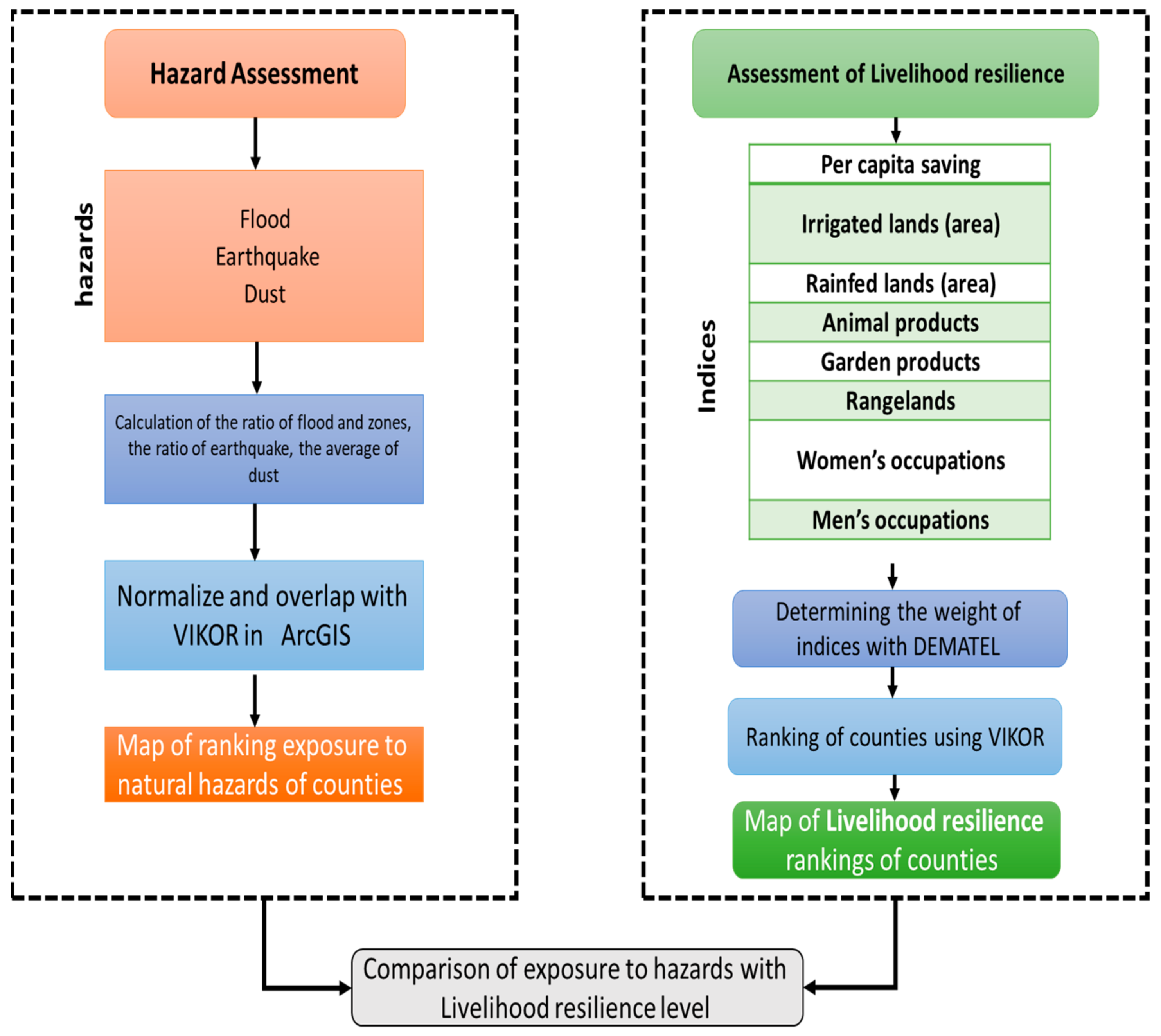
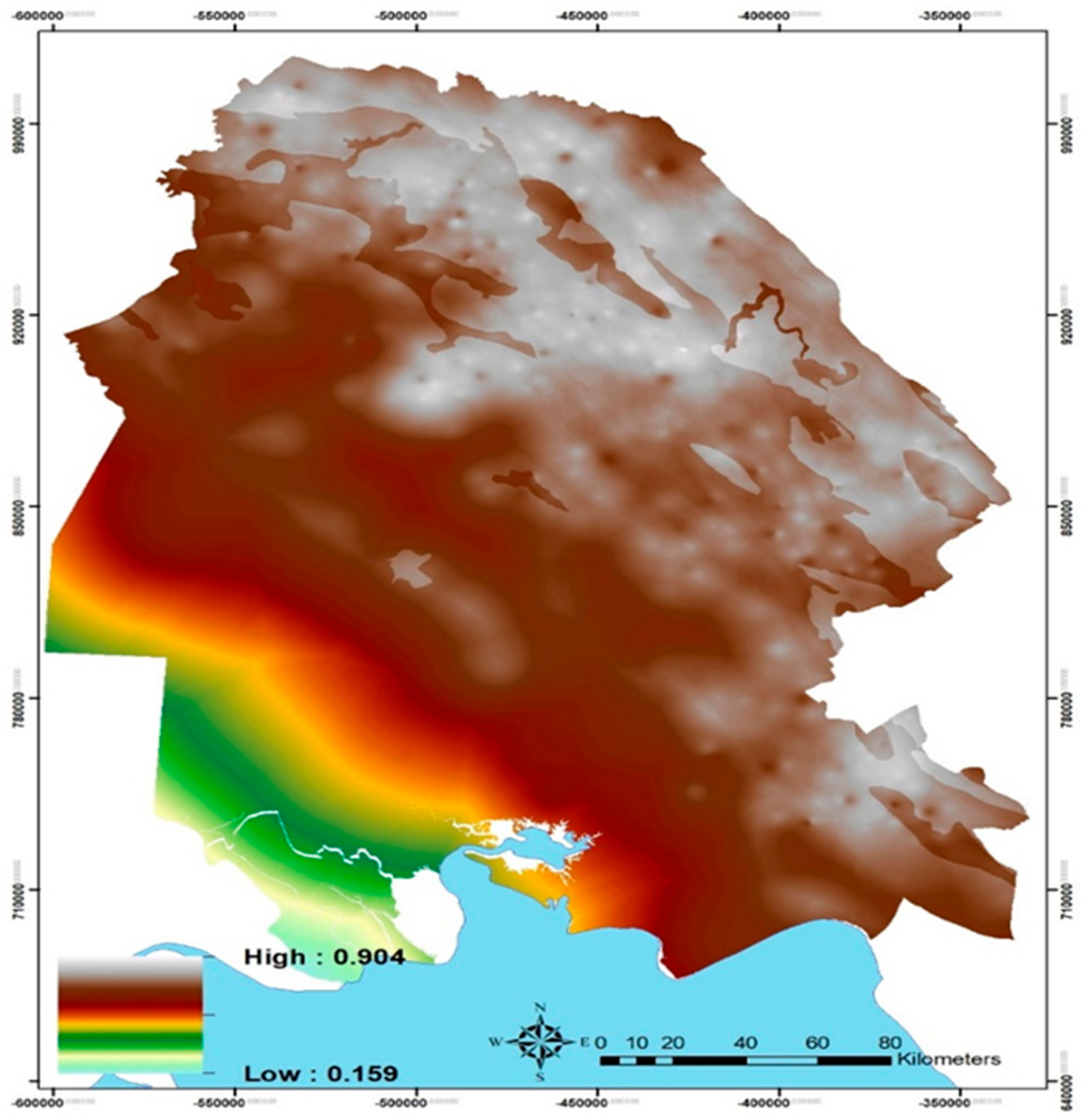

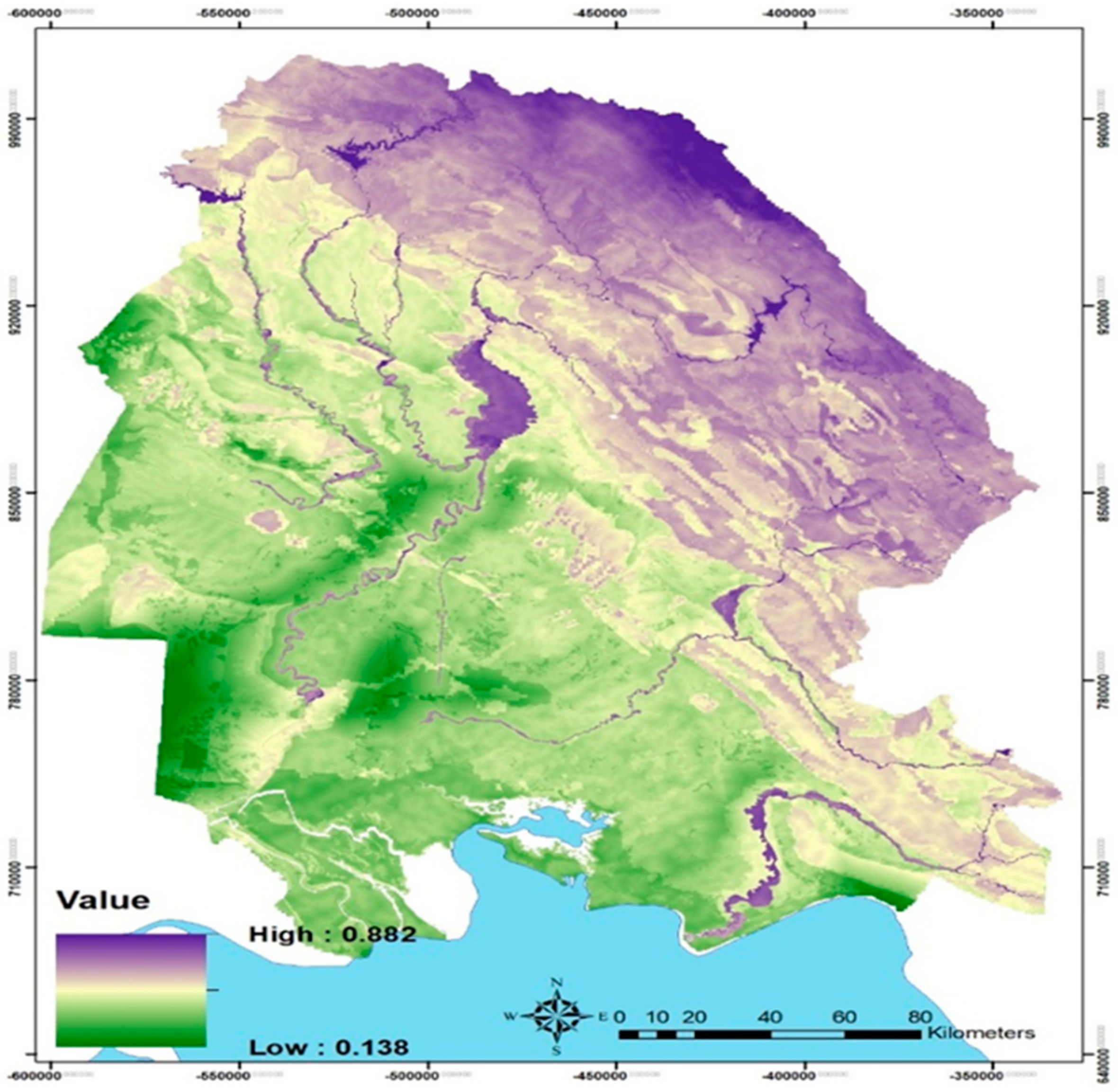
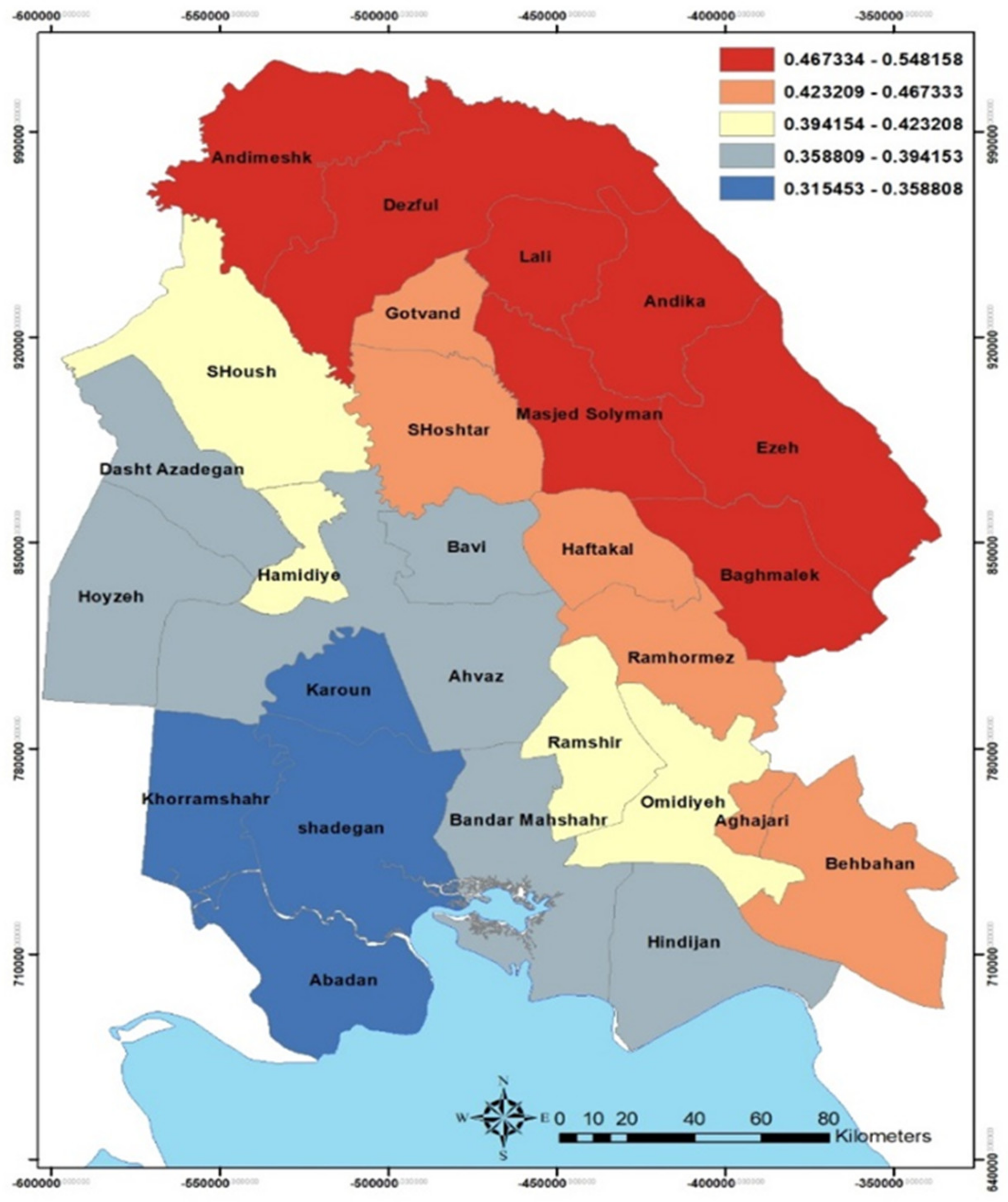
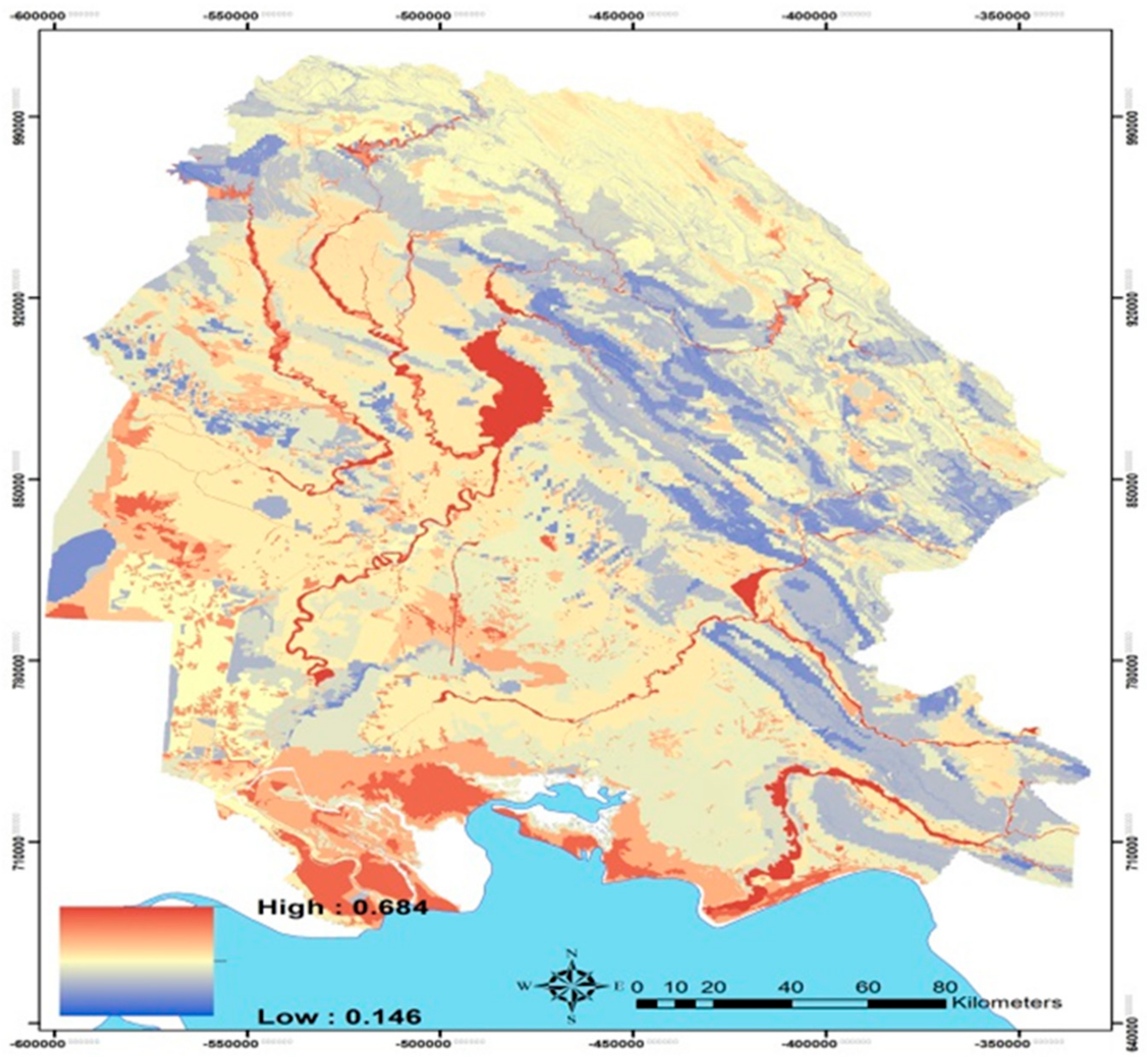
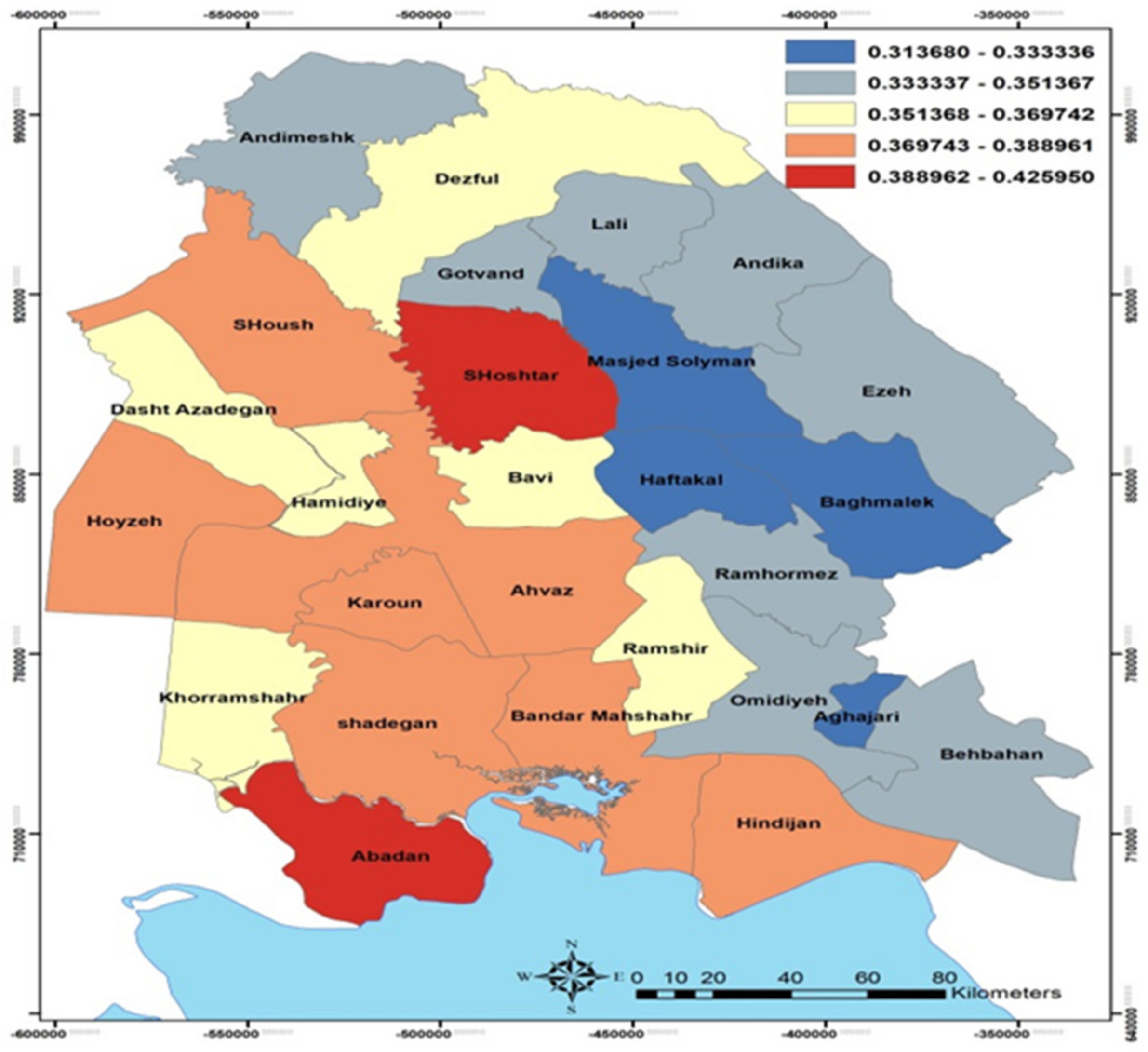

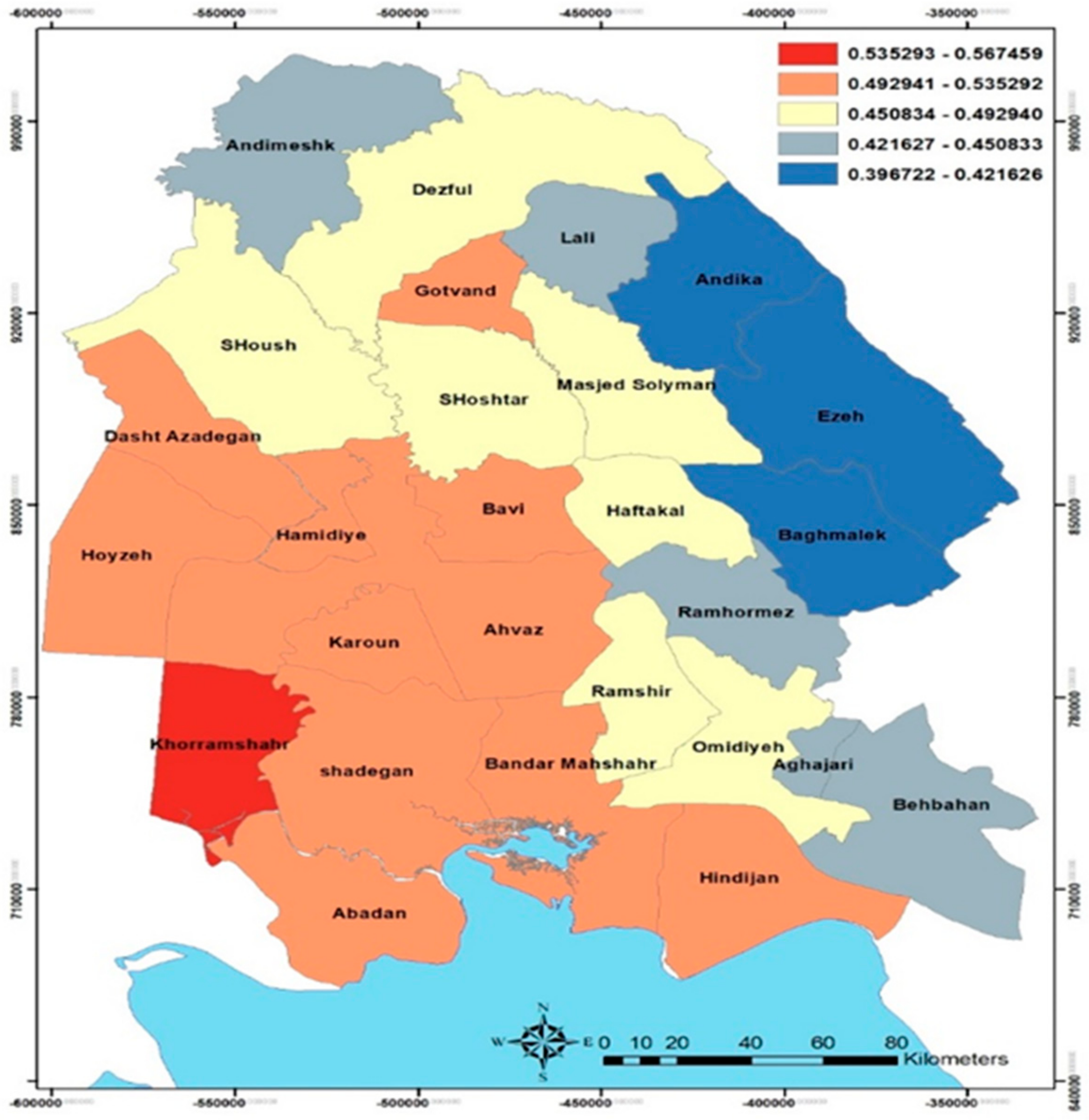

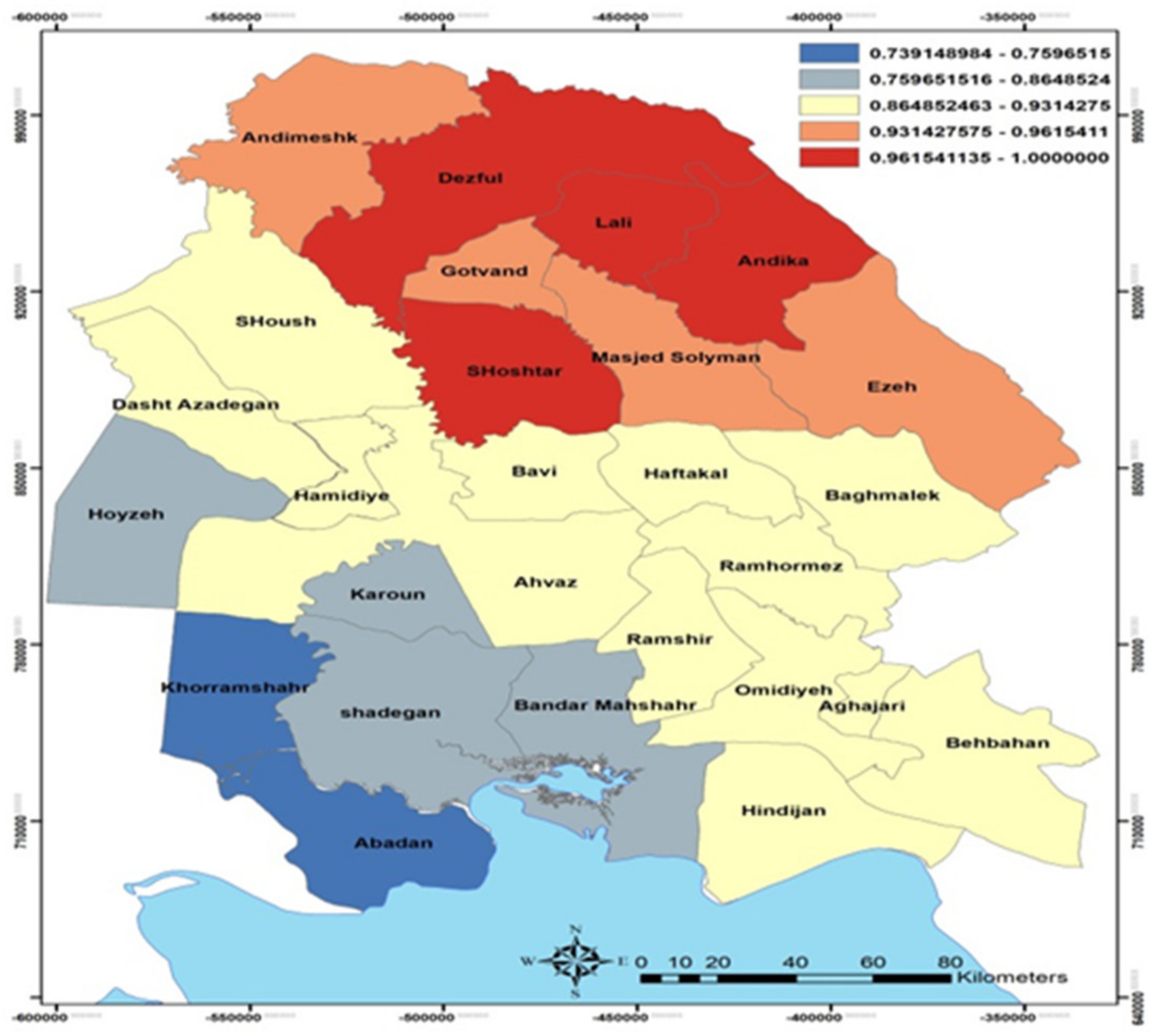
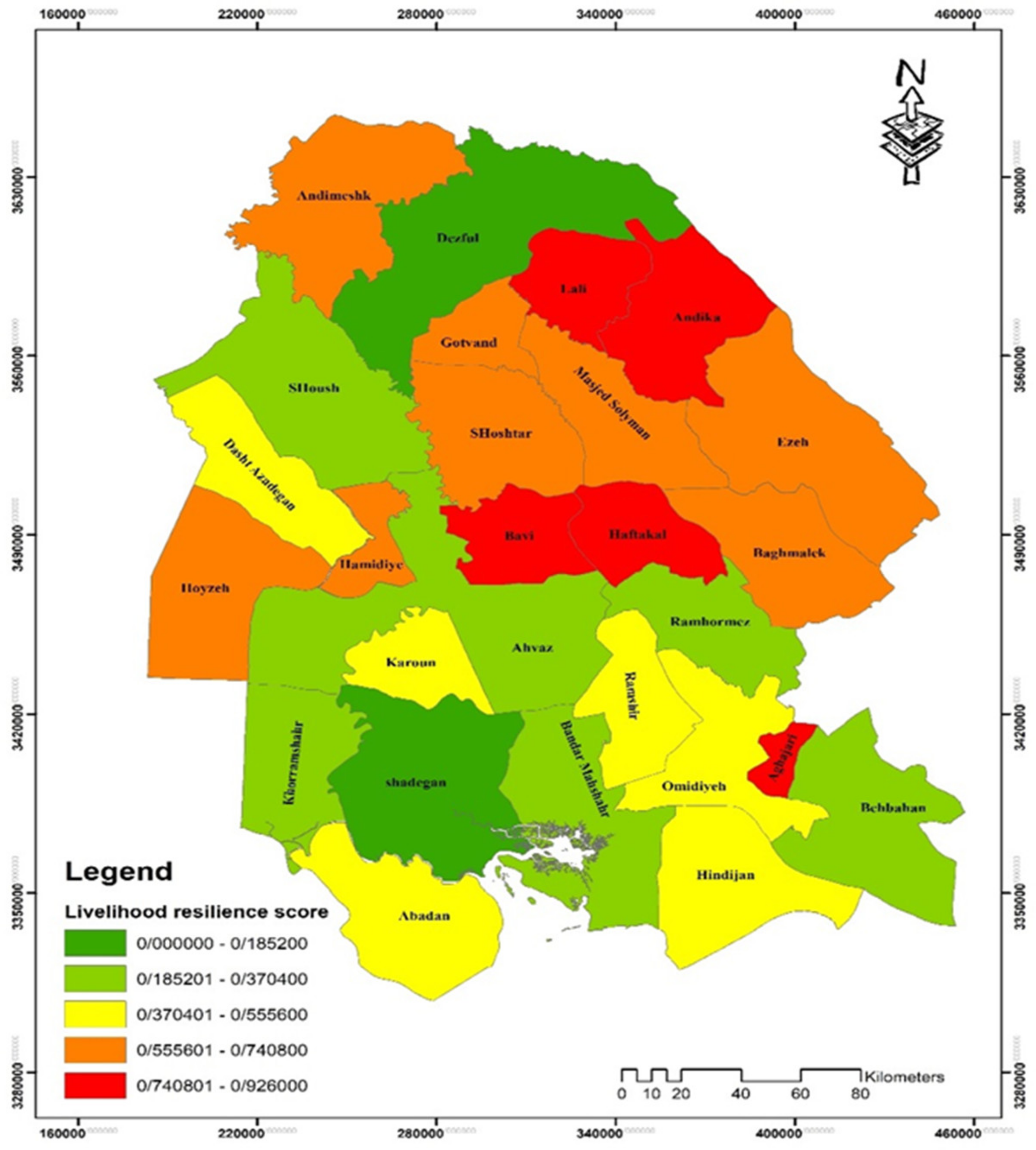
| Hazard | Indicator | Reference | Feature/Character/Nature | Effect | Weight by the Best-Worst Method |
|---|---|---|---|---|---|
| Earthquake | Distance from the fault | [50] | Meter | Decreasing | 0.4017 |
| Distance from previous earthquake centers | Meter | Decreasing | 0.1674 | ||
| The density of previous earthquakes | Density | Increasing | 0.1255 | ||
| The intensity of previous earthquakes | [50] | Richter | Increasing | 0.1004 | |
| Earthquake depth | Meter | Decreasing | 0.0837 | ||
| Soil type | [6] | Type | Increasing | 0.0837 | |
| Slope | [50] | Degree | Increasing | 0.0377 | |
| Total weight | 1 | ||||
| Flood | Distance from the river | [50] | Meter | Decreasing | 0.2879 |
| Flood zones | Field | Increasing | 0.1892 | ||
| Precipitation | [6] | Millimeter | Increasing | 0.1344 | |
| Slope | [50] | Degree | Increasing | 0.1008 | |
| Drainage density | [50] | Density | Increasing | 0.0806 | |
| Vegetation density | Density | Decreasing | 0.0672 | ||
| Erosion rate | [50] | Type | Increasing | 0.0576 | |
| Soil permeability | Type | Decreasing | 0.0576 | ||
| Land use | [50] | Type | Increasing | 0.0247 | |
| Total weight | 1 | ||||
| Flood absorption | Slope | [50] | Degree | Decreasing | 0.2288 |
| Flood zones | [6] | Field | Increasing | 0.1945 | |
| Distance from the river | [6] | Meter | Decreasing | 0.1236 | |
| Soil permeability | [6,50] | Type | Decreasing | 0.1121 | |
| Precipitation | Millimeter | Increasing | 0.0847 | ||
| Land use | [50] | Type | Increasing | 0.0778 | |
| Vegetation density | Density | Decreasing | 0.0686 | ||
| Drainage density | [6] | Density | Increasing | 0.0572 | |
| Erosion rate | [50] | Type | Increasing | 0.0526 | |
| Drought | Total weight | 1 | |||
| Precipitation | [6] | Millimeter | Decreasing | 0.3501 | |
| Temperature | [50] | Celsius | Increasing | 0.2387 | |
| Evaporation | [6] | Cubic meter | Increasing | 0.1592 | |
| Water network density | [51] | Density | Decreasing | 0.1194 | |
| Height | [6] | Meter | Decreasing | 0.0955 | |
| Land use | [6] | Type | Increasing | 0.0371 | |
| Total weight | 1 | ||||
| Indicator | Defention | References | Impact |
|---|---|---|---|
| Per capita saving | The average amount of bank deposits per person in a particular community or region. | [56,57] | Increasing |
| Irrigated lands (area) | Cultivated areas using water resources | [58] | Increasing |
| Rainfed lands (area) | Rainfed land areas refer to lands that depend solely on natural rainfall. | [58] | Increasing |
| Animal products | The amount of production of livestock products per ton. | [32] | Increasing |
| Garden products | The amount of production of garden products per ton | [59] | Increasing |
| Rangelands | Amount of land covered with natural vegetation for grazing per hectare. | [60] | Increasing |
| Women’s occupations | Women’s employment rate | [61] | Increasing |
| Men’s occupations | Men’s employment rate | [61] | Increasing |
| County | Earthquake | Flood Exposure | Flood Absorption | Drought | Multi-Hazard Index | |||||
|---|---|---|---|---|---|---|---|---|---|---|
| Value | Rank | Value | Rank | Value | Rank | Value | Rank | Value | Rank | |
| Dezful | 0.769 | 5 | 0.542 | 4 | 0.363 | 13 | 0.482 | 15 | 1.000 | 1 |
| Lali | 0.785 | 2 | 0.542 | 3 | 0.342 | 22 | 0.451 | 20 | 0.983 | 2 |
| Shoshtar | 0.755 | 7 | 0.464 | 11 | 0.404 | 2 | 0.493 | 13 | 0.981 | 3 |
| Andika | 0.793 | 1 | 0.548 | 1 | 0.348 | 17 | 0.422 | 25 | 0.979 | 4 |
| Masjed Solyman | 0.781 | 3 | 0.502 | 7 | 0.314 | 27 | 0.478 | 17 | 0.962 | 5 |
| Gotvand | 0.742 | 11 | 0.467 | 8 | 0.351 | 16 | 0.505 | 12 | 0.958 | 6 |
| Andimeshk | 0.767 | 6 | 0.510 | 6 | 0.345 | 19 | 0.442 | 22 | 0.958 | 7 |
| Ezeh | 0.773 | 4 | 0.542 | 2 | 0.343 | 21 | 0.397 | 27 | 0.954 | 8 |
| Baghmalek | 0.745 | 10 | 0.514 | 5 | 0.333 | 24 | 0.412 | 26 | 0.931 | 9 |
| Haftakal | 0.736 | 12 | 0.462 | 12 | 0.327 | 26 | 0.475 | 18 | 0.927 | 10 |
| Behbahan | 0.752 | 8 | 0.456 | 13 | 0.344 | 20 | 0.432 | 24 | 0.920 | 11 |
| Aghajari | 0.752 | 9 | 0.465 | 9 | 0.328 | 25 | 0.435 | 23 | 0.918 | 12 |
| Ramhormez | 0.730 | 13 | 0.465 | 10 | 0.341 | 23 | 0.443 | 21 | 0.917 | 13 |
| Shoush | 0.690 | 15 | 0.416 | 15 | 0.373 | 8 | 0.492 | 14 | 0.913 | 14 |
| Bavi | 0.687 | 16 | 0.394 | 18 | 0.368 | 11 | 0.511 | 10 | 0.909 | 15 |
| Hamidiye | 0.678 | 17 | 0.398 | 17 | 0.366 | 12 | 0.516 | 5 | 0.908 | 16 |
| Omidiyeh | 0.718 | 14 | 0.423 | 14 | 0.346 | 18 | 0.463 | 19 | 0.905 | 17 |
| Hindijan | 0.664 | 20 | 0.393 | 19 | 0.377 | 6 | 0.512 | 8 | 0.902 | 18 |
| Dasht Azadegan | 0.675 | 19 | 0.382 | 21 | 0.362 | 14 | 0.514 | 6 | 0.896 | 19 |
| Ramshir | 0.678 | 18 | 0.403 | 16 | 0.361 | 15 | 0.478 | 16 | 0.890 | 20 |
| Ahvaz | 0.645 | 21 | 0.374 | 22 | 0.372 | 9 | 0.508 | 11 | 0.881 | 21 |
| Karoun | 0.605 | 22 | 0.359 | 24 | 0.389 | 3 | 0.512 | 7 | 0.865 | 22 |
| Hoyzeh | 0.553 | 24 | 0.383 | 20 | 0.373 | 7 | 0.520 | 4 | 0.848 | 23 |
| Bandar Mahshahr | 0.567 | 23 | 0.367 | 23 | 0.379 | 5 | 0.511 | 9 | 0.846 | 24 |
| Shadegan | 0.483 | 25 | 0.351 | 26 | 0.386 | 4 | 0.524 | 3 | 0.809 | 25 |
| Khorramshahr | 0.385 | 26 | 0.315 | 27 | 0.370 | 10 | 0.567 | 1 | 0.760 | 26 |
| Abadan | 0.280 | 27 | 0.352 | 25 | 0.426 | 1 | 0.535 | 2 | 0.739 | 27 |
| Indicator | R | J | R + J | R − J | ||
|---|---|---|---|---|---|---|
| Per capita saving | 1.7 | 2.54 | 3.71 | −1.37 | 3.95 | 0.175 |
| Employed men | 1.47 | 2.23 | 3.70 | −0.76 | 3.78 | 0.167 |
| Employed women | 1.12 | 2.19 | 3.31 | −1.08 | 3.48 | 0.154 |
| Irrigated lands | 2.24 | 0.33 | 2.57 | 1.91 | 3.20 | 0.142 |
| Rainfed lands | 1.7 | 0.23 | 1.39 | 0.94 | 1.68 | 0.074 |
| Animal production | 1.39 | 1.43 | 2.83 | −0.04 | 2.83 | 0.125 |
| Garden production | 1.10 | 1.47 | 2.57 | −0.36 | 2.60 | 0.115 |
| Range lands | 0.75 | 0.00 | 0.75 | 0.75 | 1.07 | 0.047 |
| Counties | Q | Counties | Q |
|---|---|---|---|
| Abaden | 0.46 | Dashte Azadeghan | 0.47 |
| Aghajari | 0.77 | Ramshir | 0.48 |
| Omidiyeh | 0.50 | Ramhormoz | 0.37 |
| Andika | 0.93 | Shadegan | 0.16 |
| Andimeshk | 0.58 | Shush | 0.32 |
| Ahvaz | 0.27 | Shushtar | 0.69 |
| Izeh | 0.60 | Karun | 0.46 |
| Bagh-e Malek | 0.57 | Gotvand | 0.62 |
| Bavi | 0.75 | Lali | 0.81 |
| Mahshahr | 0.28 | Masjed Soleyman | 0.72 |
| Behbahan | 0.31 | Haftgel | 0.83 |
| Hamidiyeh | 0.70 | Hendijan | 0.46 |
| Khoramshahr | 0.35 | Hoveyzeh | 0.58 |
| Dezful | 0.00 |
Disclaimer/Publisher’s Note: The statements, opinions and data contained in all publications are solely those of the individual author(s) and contributor(s) and not of MDPI and/or the editor(s). MDPI and/or the editor(s) disclaim responsibility for any injury to people or property resulting from any ideas, methods, instructions or products referred to in the content. |
© 2024 by the authors. Licensee MDPI, Basel, Switzerland. This article is an open access article distributed under the terms and conditions of the Creative Commons Attribution (CC BY) license (https://creativecommons.org/licenses/by/4.0/).
Share and Cite
Esmailzadeh, A.; Arvin, M.; Ebrahimi, M.; Kazemi Garajeh, M.; Afzali Goruh, Z. Measuring Livelihood Resilience in Multi-Hazard Regions: A Case Study of the Khuzestan Province in the Persian Gulf Coast. Earth 2024, 5, 1052-1079. https://doi.org/10.3390/earth5040054
Esmailzadeh A, Arvin M, Ebrahimi M, Kazemi Garajeh M, Afzali Goruh Z. Measuring Livelihood Resilience in Multi-Hazard Regions: A Case Study of the Khuzestan Province in the Persian Gulf Coast. Earth. 2024; 5(4):1052-1079. https://doi.org/10.3390/earth5040054
Chicago/Turabian StyleEsmailzadeh, Abdulsalam, Mahmoud Arvin, Mohammad Ebrahimi, Mohammad Kazemi Garajeh, and Zahra Afzali Goruh. 2024. "Measuring Livelihood Resilience in Multi-Hazard Regions: A Case Study of the Khuzestan Province in the Persian Gulf Coast" Earth 5, no. 4: 1052-1079. https://doi.org/10.3390/earth5040054
APA StyleEsmailzadeh, A., Arvin, M., Ebrahimi, M., Kazemi Garajeh, M., & Afzali Goruh, Z. (2024). Measuring Livelihood Resilience in Multi-Hazard Regions: A Case Study of the Khuzestan Province in the Persian Gulf Coast. Earth, 5(4), 1052-1079. https://doi.org/10.3390/earth5040054






